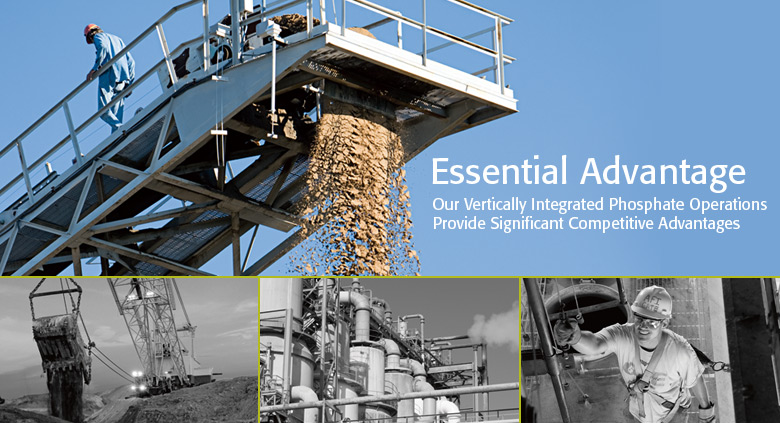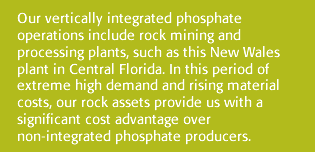

We are the largest producer of finished phosphate crop nutrients in the world and our size and scale provide inherent advantages to Mosaic in nearly every type of economic cycle. In these times of extremely high demand and high raw material costs, certain aspects of our phosphate operations are proving to be invaluable.
Mosaic's most important strategic advantage is found 15 to 50 feet below ground in Central Florida. Our five mines supply the phosphate rock that is the key mineral for phosphate fertilizer and phosphate-based animal feed products. Our rock assets provide us with a significant competitive advantage over non-integrated phosphate producers. These producers, who supply nearly a third of world demand, must purchase rock to manufacture their finished fertilizer products. As a result, their input costs are significantly higher than those of Mosaic. A non-integrated producer, for example, has had to pay as much as $550 per tonne for rock during the past year. In comparison, our rock costs have been less than $50 per tonne.
RAW MATERIAL COSTS
In addition to rock, sulfur and ammonia are the other key raw materials in the process that produce phosphate fertilizer. Costs have escalated dramatically over the past several months as demand for these materials and natural gas prices have surged. Sulfur, which is a byproduct of oil and natural gas refining, has been particularly volatile in terms of price and availability. Our sulfur logistics and transportation assets along the Gulf Coast, where the majority of North American sulfur capacity resides, has proven to be another proprietary advantage in this period of intense demand.
Ammonia, which is produced from natural gas, is another raw material that has experienced significant price escalation. We produce approximately one third of our ammonia needs at our Louisiana facility at an advantageous price in comparison to current market prices for ammonia. We expect these assets, combined with our purchasing scale and strong supplier relationships, will continue to help ensure a supply of these critical raw materials for our production needs.
More Capacity, More Efficiency
During fiscal 2009, we plan to invest further in our phosphate assets in order to realize additional operating efficiencies and to expand capacity to help meet high demand for crop nutrients. One of these investments involves the restart of sulfuric and phosphoric acid production at our South Pierce facility in Florida. This increased acid production will be used to utilize excess granulation capacity at our Florida New Wales plant, producing more finished product.
At our Riverview, Florida concentrates plant, an additional waste heat recovery system will deliver further energy savings. Also at Riverview, investments in new equipment will expand production capacity for our MicroEssentials™ product line. MicroEssentials™ is an excellent example of product innovation at Mosaic. This unique product meets the needs of customers who require additional sulfur and micro-nutrients in specific cropping regions. With three patented products for a variety of crops, adoption rates for these products are gaining momentum among farmers.
Strong Fundamentals
Compared to the first half of this decade, phosphate fundamentals have improved dramatically and have the potential to strengthen even further. With the exception of China, phosphate rock production has remained flat over the past decade. Increasingly, China is diverting a portion of its phosphate resources to its own farmers as part of an effort to contain food price inflation. With costs for greenfield projects up sharply, no significant capacity expansion is expected until at least 2011.
Given continued high demand, we anticipate the extremely tight supply of phosphate rock to continue for the foreseeable future. In addition, our vertically integrated operations will continue to provide us with competitive advantages in this environment and position our Phosphates business to perform well for customers and shareholders alike.